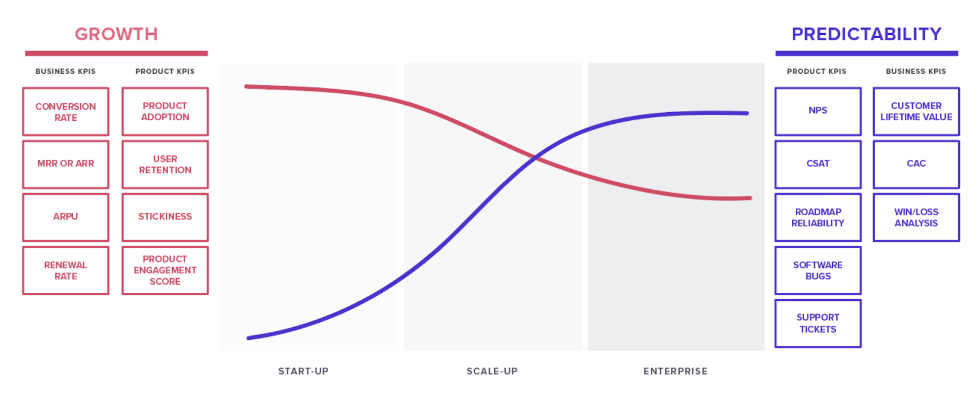Editor’s note: This post originally appeared on the Pendo blog.
Traditionally, as companies mature, priorities shift from a focus on absolute growth to a focus on efficiency and profitability. This shift is reflected in the KPIs organizations use to measure success at these stages: for budding start-ups, growth KPIs matter more than those of predictability — but at a certain point in the scaling process, the two switch.

The shift towards predictability is happening sooner now, as some investors and start-up leaders move away from a mantra of “growth at all costs” and towards the goal of turning a profit. And although a company’s stage is often a determining factor, every once in awhile an event comes along that forces organizations to swiftly rethink their strategy. Take, for example, when Tableau missed its earnings in 2016 and the entire SaaS industry immediately pivoted to focus on efficiency when investors became skittish.
Today, we find ourselves facing another drastic event that’s impacting how companies think about their paths forward. For those that have been in (or were planning for) growth mode, the economic fallout from COVID-19 may mean a forced and sudden shift towards more predictable business results. With an uncertain economic outlook and no clear timeline to go by, the way organizations view success is likely to change.
Below, you’ll find the KPIs we believe product teams should hone in on during this wave of uncertainty, broken down by business KPIs and product KPIs.
Business KPIs: Look inward at your current customers and retention
During periods of rapid growth, companies usually favor business metrics related to new revenue coming in — like conversion rate, monthly recurring revenue (MRR) and annual recurring revenue (ARR), and average revenue per user (ARPU). While these metrics still matter during an economic downturn, customer retention rises in importance. As a first step, companies should examine retention as a pulse check on how business has been impacted. Then, in order to understand where to steer efforts to maximize retention, product leaders should focus on business KPIs related to their current customer base, and why certain prospects didn’t become customers:
- Customer lifetime value (CLV): it’s important to determine the total revenue you expect each customer account to generate for your business. By doing this, you’ll be able to identify which customer segments are the most valuable and can prioritize resources accordingly.
- Customer acquisition cost (CAC): in order to know just how expensive acquiring a new customer is, calculate your customer acquisition cost to determine if (and by how much) you need to reduce it.
- Win/loss analysis: understanding why a prospect did or did not ultimately convert and become a customer helps highlight where the product may be falling short, or what its key differentiators are.
Product KPIs: Double down on usage, stability, and satisfaction
Product metrics have become increasingly central to quantifying business success, especially for organizations that are product-led. When companies are thinking about growth, they tend to lean on metrics like product adoption, stickiness, and product engagement to understand how users are interacting with the product. Since it’s more cost-effective to retain (and even grow) a current customer than to secure a new one, during periods of uncertainty teams should track product usage first and foremost to understand if it has changed dramatically for existing customers. Then, it’s important to track if the product is doing what it’s supposed to do — and how it’s impacting users. These are the product KPIs to focus on:
- Product usage: while companies should always measure product usage, this information is critical when striving for efficiency. Have there been any changes in usage patterns? Is your champion still heavily engaged in the product? Are people with different roles than your typical user beginning to use the product? By examining these trends, you’ll be better able to serve users as their needs evolve with the changing economic climate.
- Net Promoter Score (NPS): since you should be hyper-focused on your customers during this time, NPS is helpful in quantifying your customers’ loyalty towards your product.
- Customer satisfaction score (CSAT): in addition to loyalty, use CSAT surveys to gain a sense of your customers’ satisfaction with your product. Knowing how your customers feel is a good indicator of whether or not they’ll stick around.
- Roadmap reliability: more likely than not, your roadmap will need to shift to adapt to the new reality. As business priorities change, make sure the roadmap you’re sharing with customers and the broader organization is delivering what is most needed.
- Bugs and support tickets: these are two common indicators of product performance and stability. Track product bugs broken down by feature as well as how quickly they’re being fixed (this part is key). You should also keep track of the number of support tickets coming in, and if certain issues arise over and over again.


